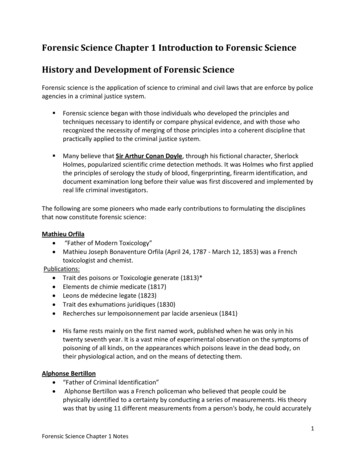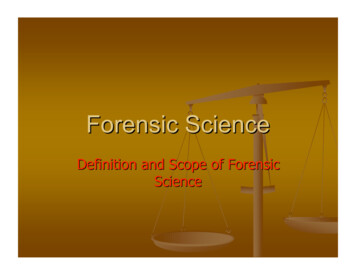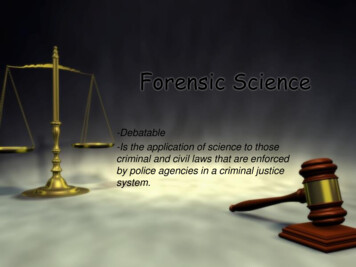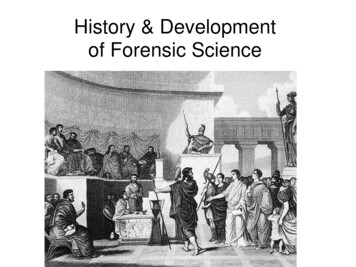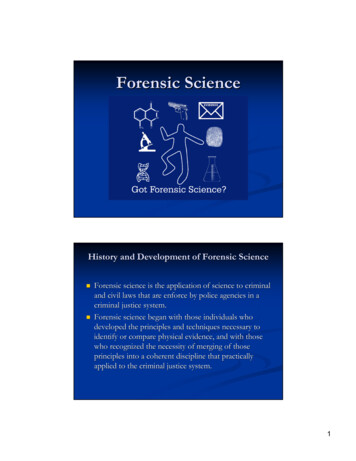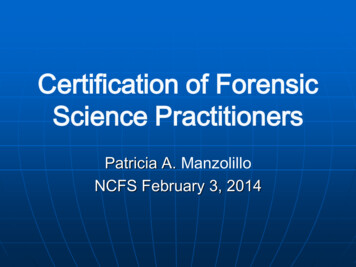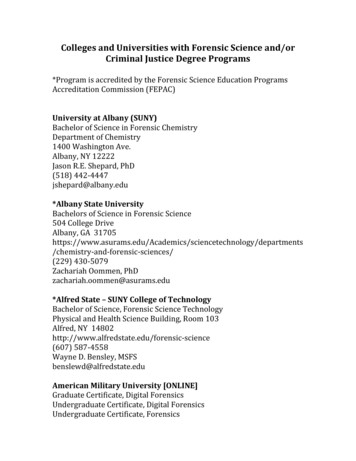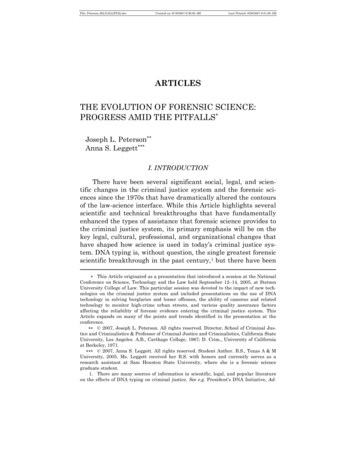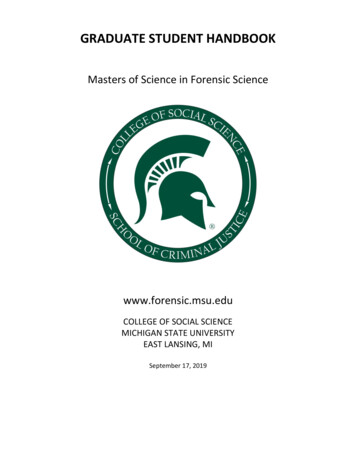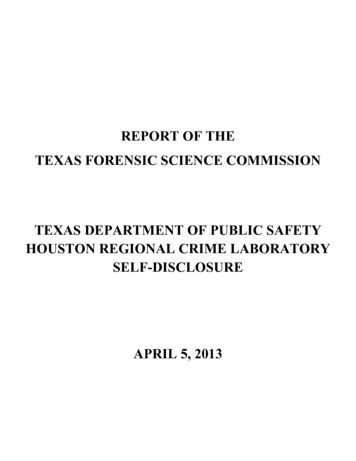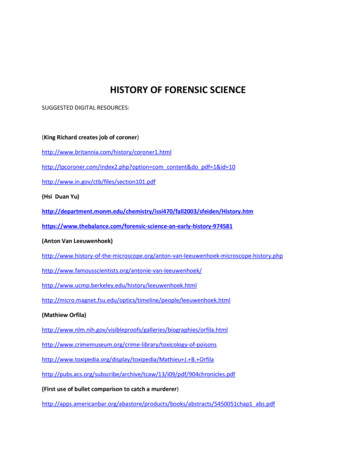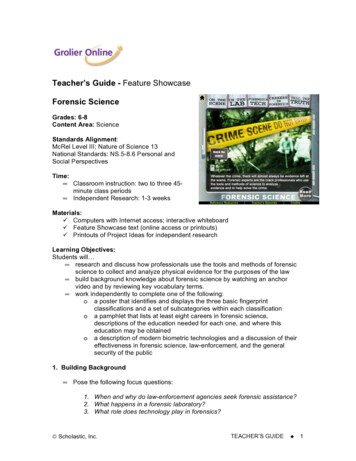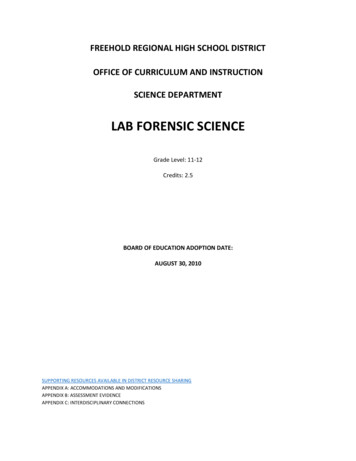
Transcription
FREEHOLD REGIONAL HIGH SCHOOL DISTRICTOFFICE OF CURRICULUM AND INSTRUCTIONSCIENCE DEPARTMENTLAB FORENSIC SCIENCEGrade Level: 11-12Credits: 2.5BOARD OF EDUCATION ADOPTION DATE:AUGUST 30, 2010SUPPORTING RESOURCES AVAILABLE IN DISTRICT RESOURCE SHARINGAPPENDIX A: ACCOMMODATIONS AND MODIFICATIONSAPPENDIX B: ASSESSMENT EVIDENCEAPPENDIX C: INTERDISCIPLINARY CONNECTIONS
Course PhilosophyLab Forensic Science is the application of inquiry-based laboratory science skills to criminal and civil law. Incriminal cases, forensic science examines physical evidence that can be used to establish connections betweenindividuals and criminal events and circumstances. The application of the scientific method is essential toForensic Science – observation, collection of data, classification of evidence, examining relationships, formingand testing hypotheses and drawing conclusions are useful for determining the evidential value of crime sceneand related evidence. Students will learn to work in teams and utilize forensic science techniques, criticalthinking skills, problem-solving skills, and technology in order to analyze crime scene evidence. The ultimategoal is to provide the students with 21st Century Learning skills and an overall view of Forensic Science whichhas been subject to increased interest and popularity in recent years.Course DescriptionThis half-year laboratory course for juniors and seniors provides an introduction to the field of forensicscience. The course of study includes the applications of forensic science concepts (which involves biology,chemistry, and physics) to analyze and investigate evidence that may be discovered in a criminal investigation.Classroom activities include: laboratory investigations and activities, research projects, famous case studies,lab practicums, career exploration, and the infusion of technology throughout the scope of the course.
Freehold Regional High School DistrictCurriculum MapLab Forensic .12 B1-4 ;C1-3; D1-38.1.12 F1-29.1.12 A1, A49.1.12 F2, F6AssessmentsEssential QuestionsDiagnostic(before)Forensic Science is theintegration of corescientific disciplines.How has Forensic Science developed over time due toadvances in science, technology and society?How has science become integrated into the practice of law?How do fictitious portrayals of Forensic Science compare toreal-world Forensic Science?PretestStudent SurveyOral Questions andDiscussionAnticipatory SetQuestionsQuizzesChapter TestWritten AssignmentsOral ationsLab PracticumProjectsFinal Exam5.1.12 B1-4 ; C13; D1-38.1.12 F1-29.1.12 A1, A49.1.12 F2, F6Forensic scienceinvolves a variety ofcareers.What services does a crime lab provide to law enforcementpersonnel?Which professionals make up a crime scene unit?What contributions do the forensic scientists make to aninvestigation?What are the differences between perceived and actual rolesof forensic scientists?PretestStudent SurveyOral Questions andDiscussionAnticipatory SetQuestionsLab PracticumProjectsFinal Exam5.1.12 A1-35.1.12 B1-4 ; C13; D1-38.1.12 F1-29.1.12 A1, A49.1.12 F2, F6Crime scenes must beprocessed in aprocedural manner.Why must a crime scene be secured and processed in amethodical and procedural manner?How is the location and handling of evidence essential tocrime scene investigation?PretestStudent SurveyOral Questions andDiscussionAnticipatory SetQuestions5.1.12 A1-35.1.12 B1-4 ; C13; D1-35.2.12 E1-35.3.12 A1-6 ;B1-2 ; D18.1.12 F1-29.1.12 A1, A49.1.12 F2, F6Evidence determines themethod by which acrime has beencommitted.How is evidence used to determine whether a crime hasbeen committed?How are various types of evidence tested and analyzed?What is the value of different types of evidence?PretestStudent SurveyOral Questions andDiscussionAnticipatory SetQuestionsQuizzesChapter TestWritten AssignmentsOral ationsQuizzesChapter TestWritten AssignmentsOral ationsQuizzesChapter TestWritten AssignmentsOral ationsFormative(during)Summative(after)Lab PracticumProjectsFinal ExamLab PracticumProjectsFinal Exam4
Freehold Regional High School DistrictCourse Proficiencies and PacingLAB FORENSIC SCIENCEUnit TitleUnit #1: Introduction toForensic ScienceUnit #2: Crime SceneInvestigation andEvidenceCollectionUnit #3: Fingerprints andother PatternEvidenceUnit #4: Trace EvidenceUnit Understandings and GoalsForensic Science is the integration of core scientific disciplines.Forensic science involves a variety of careers.1. Students will recognize the major contributors to the development of ForensicScience including the advancements in tools, techniques, and crime labservices.2. Students will identify various specialty professions within the field of ForensicScience.3. Students will explain the differences between the perceived and actual roles ofa forensic scientist.Crime scenes must be processed in a procedural manner.Evidence is needed to determine the method by which a crime has been committed.1. Students will explain the procedures used to process a crime scene.2. Students will explain the proper way to classify and process evidence.Crime scenes must be processed in a procedural manner.Evidence is needed to determine the method by which a crime has been committed.1. Students will identify patterns and characteristics of various types of patternevidence.2. Students will demonstrate various procedures used by the forensic scientistwhen collecting and preserving impression evidence.3. Students will explain the importance of impression databases available toforensic scientists.Crime scenes must be processed in a procedural manner.Evidence is needed to determine the method by which a crime has been committed.1. Students will identify trace evidence characteristics that are most useful inforensic comparisons.2. Students will demonstrate procedures used by the forensic scientist whenprocessing trace evidence.3. Students will explain the importance of trace evidence databases available toforensic scientists.RecommendedDuration2 weeks3 weeks2 weeks2 weeks5
Unit TitleUnit #5: DocumentExaminationUnit #6: Serology and BloodPattern AnalysisUnit #7: DNAUnit #8: Forensic Pathologyand AnthropologyUnit Understandings and GoalsCrime scenes must be processed in a procedural manner.Evidence is needed to determine the method by which a crime has been committed.1. Students will identify the characteristics of questioned documents that are mostuseful in forensic comparisons.2. Students will demonstrate procedures used by forensic scientists to processquestioned documents.3. Students will explain the importance of evidence databases available toforensic scientists.Crime scenes must be processed in a procedural manner.Evidence is needed to determine the method by which a crime has been committed.1. Students will identify characteristics of body fluids that are most useful inforensic comparisons.2. Students will demonstrate procedures used by forensic scientists whenprocessing blood evidence.3. Students will explain the importance of evidence databases available toforensic scientists.Crime scenes must be processed in a procedural manner.Evidence is needed to determine the method by which a crime has been committed.1. Students will identify the characteristics of DNA that is most useful in forensiccomparisons.2. Students will demonstrate procedures used by the forensic scientist whenprocessing DNA evidence.3. Students will explain the importance of DNA databases available to forensicscientists.Crime scenes must be processed in a procedural manner.Evidence is needed to determine the method by which a crime has been committed.1. Students will identify the characteristics of human remains that are most usefulin forensic comparisons.2. Students will demonstrate procedures used by the forensic scientist whenprocessing human remains.RecommendedDuration2 weeks2 weeks2 weeks2 weeks6
Freehold Regional High School DistrictLab Forensic ScienceUnit #1: Introduction to Forensic ScienceEnduring Understandings: Forensic Science is the integration of core scientific disciplines.Forensic science involves a variety of careers.Essential Questions: How has Forensic Science developed over time due to advances in science, technology and society?How has science become integrated into the practice of law? How do fictitious portrayals of Forensic Science compareto real-world Forensic Science? What services does a crime lab provide to law enforcement personnel?Which professionals make up a crime scene unit? What contributions do the forensic scientists make to an investigation?What are the differences between perceived and actual roles of forensic scientists?Unit Goals: Students will recognize the major contributors to the development of Forensic Science including the advancements in tools, techniques,and crime lab services.Students will identify various specialty professions within the field of Forensic Science.Students will explain the differences between the perceived and actual roles of a forensic scientist.Duration of Unit: 2 weeksNJCCCS: 5.1.12 B1-4, C1-3, D1-3; 8.1.12 F1-2; 9.1.12 A1, A4; 9.1.12 F2, F6Content, Themes, Concepts, andInstructional ResourcesGuiding / TopicalTeaching StrategiesAssessment StrategiesSkillsand MaterialsQuestionsWhat is forensic science andwhy has science becomeintegrated into the practice oflaw?Historical timeline of forensic scienceadvancements and development of earlycrime labsLocard’s Exchange PrincipleAdmissibility of evidence (Frye and Daubertdecisions)Role and responsibilities of the expertwitnessCurrent textbookNotes; HandoutsInternet; Mobile computer labcentersLaboratory Tools and SafetyEquipmentVideo; Multimedia resourcesClass notes via lecture, PowerPoint,Smartboard, overhead projector, and classdiscussionWritten tests and quizzesHands-on lab activities and cooperativegroup work such as: create a ‘table for 2’mini crime scene that tests student powersof observation and objectivity; use a white tshirt and magnifying glass to demonstrateLocard’s Evidence Exchange PrincipleLab; ActivityCommunity resources; GuestSpeakersWho are the major contributorsto the development of forensicscience?Historical timeline of forensic scienceadvancements and development of earlycrime labsLocard’s Exchange PrincipleAdmissibility of evidence (Frye and Daubertdecisions)Role and responsibilities of the expertwitnessCurrent Event ArticlesCurrent textbookNotes; HandoutsInternet; Mobile computer labcentersLaboratory Tools and SafetyEquipmentVideo; Multimedia resourcesCommunity resources; GuestSpeakersWorksheetsProject assessmentsResearch activitiessuch as famous case studiesusing trutv.comWebquestsClass notes via lecture, PowerPoint,Smartboard, overhead projector, and classdiscussionWritten tests and quizzesHands-on lab activities and cooperativegroup work such as: create a ‘table for 2’mini crime scene that tests student powersof observation and objectivity; use a white tshirt and magnifying glass to demonstrateLocard Evidence Exchange PrincipleLab; ActivityWorksheetsProject assessmentsResearch activitiessuch as “famous forensicscientists and theircontributions” or “careers inforensic science”7
Guiding / TopicalQuestionsWhat are the various specialtyfields included within the broadrealm of forensic science?Content, Themes, Concepts, andSkillsInstructional Resourcesand MaterialsServices of a typical comprehensive crimelaboratory and comparison of modern labsdue to demographicsCurrent textbookSpecialty areas: pathology, entomology,anthropology, toxicology, serology, medicalexaminer/coroner, botany, odontology,podiatry, psychiatry, engineering, and otherexpert fields relating to forensicsInternet; Mobile computer labcentersNotes; HandoutsTeaching StrategiesAssessment StrategiesClass notes via lecture, PowerPoint,Smartboard, overhead projector, and classdiscussionHands-on lab activities and cooperativegroup work such as: match forensicprofessionals to job descriptionsLaboratory Tools, Appropriatehands-on materials, SafetyEquipmentVideo; Multimedia resourcesHow do real world roles andresponsibilities of forensicprofessionals compare tofictitious versions portrayed onfilm?Actual versus fictitious examplesCommunity resources; GuestSpeakersCurrent textbookCSI EffectNotes; HandoutsInternet; Mobile computer labcentersLaboratory Tools and SafetyEquipmentVideo; Multimedia resourcesCommunity resources; GuestSpeakersCurrent Event ArticlesClass notes via lecture, PowerPoint,Smartboard, overhead projector, and classdiscussionWritten tests and quizzesHands-on lab activities and cooperativegroup work such as: student dissection of afictitious portrayal of forensic professionals(such as seen on CSI) to highlight accuracyand embellishment as seen through theirinexperienced eyesLab; ActivityVideo such as: “Anderson Cooper 360 TheCSI Effect”WorksheetsProject assessmentsResearch activitiessuch as “careers in forensicscience” or “CSI inaccuraciesor myths” or “CSI Effectexamples”Webquests such as:csitheexperience .orgSuggestions on how to differentiate in this unit: Students with individual learning styles can be assisted through one-to-one teacher support, additional testing time, peer to peer coaching, and use of visual andauditory teaching methodsA wide variety of assessments and strategies complement the individual learning experience.8
Freehold Regional High School DistrictLab Forensic ScienceUnit #2: Crime Scene Investigation and Evidence CollectionEnduring Understandings: Crime scenes must be processed in a procedural manner.Evidence is needed to determine the method by which a crime has been committed.Essential Questions: Why must a crime scene be secured and processed in a methodical and procedural manner?How is the location and handling of evidence essential to crime scene investigation?How is evidence used to determine whether a crime has been committed?What is the value of different types of evidence?Unit Goals: Students will explain the procedures used to process a crime scene.Students will explain the proper way to classify and process evidence.Duration of Unit: 3 weeksNJCCCS: 5.1.12 A1-3, B1-4, C1-3, D1-3; 5.3.12 A1-6, B1-2, D1; 8.1.12 F1-2; 9.1.12 A1, A4; 9.1.12 F2, F6InstructionalGuiding / TopicalContent, Themes,Resources andTeaching StrategiesQuestionsConcepts, and SkillsMaterialsWhat are theresponsibilities of thefirst responder andscene technicians at acrime scene?Steps in securing, preserving,and processing a crime sceneCurrent textbookNotes; HandoutsInternet; Mobilecomputer lab centersLaboratory Tools,Appropriate hands-onmaterials, SafetyEquipmentClass notes via lecture, PowerPoint, Smartboard,overhead projector, and class discussionHands-on lab activities and cooperative group worksuch as:Create a crime scene for students to process, (indoorand/or outdoor) including take notes/description ofscene, search/locate evidence, evidence marking,measurements, drawings, photography, sketches,evidence evaluation and/or collectionAssessment StrategiesWritten tests and quizzesWorksheetsLab / ActivityProject assessmentsResearch activitiesWebquestVideo; MultimediaresourcesHow do investigatorssystematically search forcrime scene evidence?Primary/Secondary crimescenesStaged crimesSearch patternsCommunity resources;Guest SpeakersCurrent textbookNotes; HandoutsInternet; Mobilecomputer lab centersClass notes via lecture, PowerPoint, Smartboard,overhead projector, and class discussionHands-on lab activities and cooperative group worksuch as:Create a crime scene for students to process, (indoorand/or outdoor) including take notes/description ofWritten tests and quizzesWorksheetsLab / ActivityProject assessments9
Guiding / TopicalQuestionsWhat steps should betaken to thoroughlydocument, diagram, andreconstruct the crimescene?Content, Themes,Concepts, and SkillsInstructionalResources andMaterialsTeaching StrategiesAssessment StrategiesObservations about crimescene environmentEvidence markingCrime Scene and evidencePhotographyHow is evidenceproperly recognized,collected, and packaged?How is evidenceclassified?Crime scene sketchesCrime scene and evidencecontaminationExamples of evidencepackaging materialsChain of custodyDirect versus circumstantialIndividual versus classTypes of evidence (biological,chemical, etc.)Probative valueClass notes via lecture, PowerPoint, Smartboard,overhead projector, and class discussionHands-on lab activities and cooperative group worksuch as:staged disruption of class and subsequent questioningof students for eye witness detailsEyewitness testimonySuggestions on how to differentiate in this unit: Students with individual learning styles can be assisted through one-to-one teacher support, additional testing time, peer to peer coaching, and use of visual andauditory teaching methodsA wide variety of assessments and strategies complement the individual learning experience.10
Freehold Regional High School DistrictLab Forensic ScienceUnit #3: Fingerprints and Other Pattern EvidenceEnduring Understandings: Crime scenes must be processed in a procedural manner.Evidence is needed to determine the method by which a crime has been committed.Essential Questions: How is the location and handling of evidence essential to crime scene investigation?How is evidence used to determine whether a crime has been committed?How are various types of evidence tested and analyzed?What is the value of different types of evidence?Unit Goals: Students will identify patterns and characteristics of various types of pattern evidence.Students will demonstrate various procedures used by the forensic scientist when collecting and preserving impression evidence.Students will explain the importance of impression databases available to forensic scientists.Duration of Unit: 2 weeksNJCCCS: 5.1.12 A1-3, B1-4, C1-3, D1-3; 8.1.12 F1-2; 9.1.12 A1, A4; 9.1.12 F2, F6Guiding / TopicalContent, Themes, Concepts,Instructional Resources andTeaching StrategiesQuestionsand SkillsMaterialsHow is a fingerprint created?Physical development and structure ofhuman fingerprintsCurrent textbookNotes; HandoutsSecretions that make a fingerprint onsurfacesClass versus individual evidenceFingerprints do not change over time;altering or disguising fingerprintsInternet; Mobile computer lab centersLaboratory Tools, Appropriate hands-onmaterials, Safety EquipmentAssessmentStrategiesClass notes via lecture, PowerPoint,Smartboard, overhead projector, and classdiscussionWritten tests; quizzesHands-on lab activities and cooperativegroup work such as: create fingerprints onvarious surfaces and compareLab / ActivityVideo; Multimedia resourcesWorksheetsResearch activities such asJohn DillingerWebquestCommunity resources; Guest SpeakersWhat are the three majorfingerprint patterns and theirrespective sub-classes?Loop, whorl, arch characteristicsCommon ridge characteristics(minutiae)Current Event ArticlesCurrent textbookNotes; HandoutsInternet; Mobile computer lab centersLaboratory Tools, Appropriate hands-onmaterials, Safety EquipmentWhat are the three basictypes of fingerprintimpressions?Latent, patent (visible), plasticVideo; Multimedia resourcesCommunity resources; Guest SpeakersCurrent Event ArticlesClass notes via lecture, PowerPoint,Smartboard, overhead projector, and classdiscussionWritten tests and quizzesHands-on lab activities and cooperativegroup work such as: ink transfer a printonto a balloon and enlarge to view ridgecharacteristics; identify various fingerprintexamples by patternLab / ActivityClass notes via lecture, PowerPoint,Smartboard, overhead projector, and classdiscussionFamous Case Study toresearch such as: The NightStalker (Richard Ramirez)Hands-on lab activities and cooperativegroup work such as: ink transfer or pencilsmudge method to create a ten card; teacherdemo or student creati
Students will identify various specialty professions within the field of Forensic Science. Students will explain the differences between the perceived and actual roles of a forensic scientist. Duration of Unit: 2 weeks NJCCCS: 5.1.12 B1-4, C1-3, D1-3; 8.1.12 F1-2; 9.1.12 A1, A4; 9.1.
